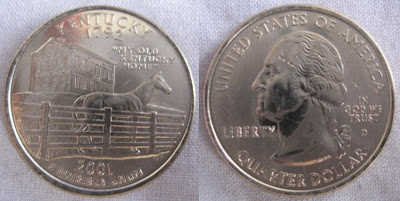Maine state quarter
 The design of the released quarter represents aspects of Maine's landscape tied to its maritime history.
The design of the released quarter represents aspects of Maine's landscape tied to its maritime history.The year that Maine became a state, 1820, is centered at the top of the quarter. Below are pictured a pine tree, a lighthouse, perched on a rocky cliff, and an Atlantic ocean-going sailing vessel accompanied by two sea birds.
The pine tree, positioned to the left of the lighthouse, represents Maine's official state tree, the white pine. The white pine represents Maine's forestry industries where mills make paper, pulp, toothpicks, and a variety of other wood products. It's also considered to be the largest conifer in the northeastern United States and some of the tallest trees in eastern North America grew in Maine. In the early days of colonization, the tall white pines of Maine were valued for ship's masts.
The white pine played an important part in the history of Maine and has been afforded appropriate recognition. In addition to being honored as Maine's state tree, the white pine also contributed its pinecone and tassel as the official state flower. It also shows up on Maine's state seal, the state flag, and in its nickname, the "Pine Tree State." Almost 90% of Maine is forested.
The lighthouse depicted on the coin is based on the Pemaquid Point Light located near Bristol, Maine. One of Maine's 65 lighthouses, the Pemaquid Point Light marks the entrance to Muscongus Bay and John Bay. In 1826, Congress made $4,000 available to build a lighthouse to ward ships from the dangerous shoals. The original stone tower, built in 1827, was replaced in 1835 by the 38-foot stone tower that stands today and continues to serve as an active aid to navigation. This lighthouse is a popular Maine attraction and is visited by around 100,000 people each year.
The schooner (large ship with two or more masts), depicted on the coin, is based on "Victory Chimes, " the last three-masted schooner of the windjammer fleet. A "windjammer" is simply a large sailing vessel. The term may have originated as a contemptuous term used by sailors on early steam vessels.
Built in 1900 in Bethel, Delaware to carry lumber up and down the shallow bays and rivers of the Chesapeake, the 132' schooner Victory Chimes is the last three-masted schooner on the East coast and the largest passenger sailing vessel (40 passengers) under U.S. flag. . She's registered as a National Historic Landmark, a reminder of the golden age of sail, and takes passengers on week-long cruises along the coast of Maine.
Louisiana state quarter
 The Louisiana quarter displays the image of Louisiana's state bird -- the pelican, a trumpet with musical notes, and the outline of the Louisiana Purchase territory, along with the inscription "Louisiana Purchase".
The Louisiana quarter displays the image of Louisiana's state bird -- the pelican, a trumpet with musical notes, and the outline of the Louisiana Purchase territory, along with the inscription "Louisiana Purchase".Thomas Jefferson bought the Louisiana Territory from Napoleon Bonaparte in 1803 for $15 million. Dubbed the "greatest real estate deal in history" the Louisiana Purchase added thirteen new states to the Union, nearly doubling its size and making it one of the largest countries in the world.
The trumpet on the coin is a tribute to the state's heritage of jazz music, a genre heard and played by millions of enthusiasts around the globe. Jazz was born in New Orleans over a hundred years ago, a combination of elements from blues, ragtime, and marching band music. A multitude of musicians propelled jazz from New Orleans' French Quarter onto the world stage, making the style a dominant force in 20th Century music.
Kentucky state quarter
 The Kentucky state quarter design incorporates "My Old Kentucky Home", a Kentucky thoroughbred and the white plank fence common to Kentucky thoroughbred farms.
The Kentucky state quarter design incorporates "My Old Kentucky Home", a Kentucky thoroughbred and the white plank fence common to Kentucky thoroughbred farms.Home is where the heart is and Kentucky wanted to send a strong message about the value of home among the people of the Commonwealth. The stately mansion engraved on the quarter is Federal Hill, built by Judge John Rowan in 1818. Judge Rowan's cousin, Stephen Foster, is thought to have written My Old Kentucky Home, the Official State Song of Kentucky, while visiting Federal Hill. Judge Rowan's 1818 home, a Kentucky treasure, is commonly referred to as "My Old Kentucky Home".
In the foreground of the coin is another official symbol of Kentucky, the thoroughbred horse, designated the Official Horse of the Commonwealth. Standing behind a white plank fence, in front of the Federal Hill mansion, the Kentucky thoroughbred represents Kentucky's long association with horse breeding and horse racing.



No comments:
Post a Comment